A set of Notebooks with a miscellany of information on the subject of relief ("letterpress") printing presses.
A terminological note: A machine of the kind covered here is called simply a "press," or, if it must be distinguished from machines in other fields, a "printing press" (vs. a wine press, a flypress, a metal stamping press, etc.) If further distinctions need to be made within the field of printing, an adjective is added; thus "a platen press" vs. "a cylinder press."
This kind of machine is not called a "letterpress." Within the general field of printing, "letterpress" is a descriptive term for a basic method of printing. It is distinguished from other basic methods of printing (e.g., from offset lithography, from intaglio printmaking, etc.) It is not a term for a machine. It is most emphatically not a verb. A printer prints using a printing press; a "letterpresser" does not do "letterpressing" on a "letterpress."
There is a machine which may properly be called a "letterpress," but it has nothing to do with printing. "Letterpress" is an alternative name for a 19th century letter copying press used to make duplicates of handwritten correspondence.
(From Collier Stationery Company [Catalog], ca. 1909. For more on the use of the letterpress, see the Antique Copying Machine section of the Early Office Museum website.)
Ironically, actual letterpresses (copy presses) are frequently mistaken for the "standing presses" used by bookbinders. A true bookbinder's standing press, while superficially similar to a letter copying press, is a much more substantial affair.
Finally, a machine of the kind to be covered here is, most emphatically, not called a "printer." A printer is either (a) a person who prints, or (b) an automated machine attached to either a telegraph line or a computer which produces readable output on paper or a similar medium.
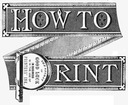
The Saxe Archive of Amatuer Press Catalogues
Stephen O. Saxe is scanning, from his notable library of printing materials, a number of the catalogues of small printing presses intended for use by amateurs. These date back as early as the 1870s and provide a fascinating picture of an avocation which is still praticed with enthusiasm. There is more than the antiquarian here; some of these catalogues remain useful operating manuals today.
The primary repository for the Stephen O. Saxe Archive of Amatuer Press Catalogues is at The Internet Archive: http://www.archive.org/details/SaxeArchiveOfAmateurPressCatalogues
In the section here (click on the icon above/left), I have the pleasure of reprinting these scans. The online tools of The Internet Archive are better than those at my disposal here; if you want to read these Catalogues in a convenient online reader, go there. But if you should need the original lossless scans, they're hosted here.
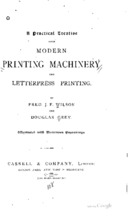
Wilson & Grey (1888)
Wilson, Fred J. F. and Douglas Grey. A Practical Treatise upon Modern Printing Machinery and Letterpress Printing . (London: Cassell & Company, 1888).
This is a local copy of the Google Books digitization of the Harvard University copy.
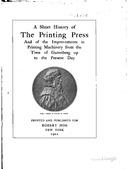
Hoe. (1902)
Hoe, Robert. A Short History of the Printing Press. (NY: Printed and Published for Robert Hoe, 1902)
(Although I have no material on his presses here, Hoe was one of the major manufacturers of printing presses in the 19th century.)
This is a local copy of the Google Books digitization of the Harvard University copy.
(But for companies best known for particular presses, see those presses.)
Comparato, Frank E. Chronicles of Genius and Folly: R. Hoe & Company and the Printing Press as a Service to Democracy . Culver City, CA: Labyrinthos, 1979.
Tucker, Stephen D., ed. Rollo G. Silver. "History of R. Hoe & Company, 1834-1885." Proceedings of the American Antiquarian Society. Vol. 82, Part 2 (October, 1972): 351-453.
This is online on the AAS website at: http://www.americanantiquariansociety.org/proceedings/44498049.pdf
I don't have much on these, despite their historic importance. Gutenberg's press (the exact form of which is unknown) would have been classified as a wooden hand press; iron hand presses were manufactured well into the 20th century as proof presses for process engraving work and continue to be used for very fine work today. Here is some essential bibliography:
Saxe, Stephen O. (author) and John DePol (wood engraver). American Iron Hand Presses. New Castle, DE: Oak Knoll Books, 1992. ISBN: 0-938768-35-2. LC: Z 249 .S23 1992 681'.62'0973-dc20 91-36587.
Oldham, Robert. A Field Guide to North American Hand Presses and Their Manufacturers. Doswell, VA: Ad Lib Press, 2006. ISBN: 978-1-4243-2901-4
Rummonds, Richard-Gabriel. Printing on the Iron Handpress. New Castle, DE: Oak Knoll Press and The British Library, in Association with Five Roses Press, 1998 Oak Knoll hardcover ISBN: 1-884718-39-6. British Library hardcover ISBN: 0-7123-4560-4. Oak Knoll softcover ISBN: 1-884718-40-X. British Library softcover ISBN: 0-7123-4561-2 Z 249 .R76 1997 686.2'253-dc21 97-26661
Rummonds, Richard-Gabriel with technical editing by Stephen O. Saxe. Nineteenth-Century Printing Practices and the Iron Handpress. New Castle, DE: Oak Knoll Press and The British Library, 2 vols. in Association with Five Roses Press, 2004. Oak Knoll hardcover ISBN: 1-58456-088-6. British Library hardcover ISBN: 0-7123-4867-0 Oak Knoll softcover ISBN: 1-58456-100-9. LC: Z 124 .R86 2004 686.2'09'034-dc21 2003045960,
Harris, Elizabeth and Clinton Sisson. The Common Press: Being a Record, Description and Delineation of the Early Eighteenth-Century Handpress in the Smithsonian Institution Boston: David R. Godine, 1978. ISBN: 0-87923-211-0. LC: >77-79005.
This is an extraordinary book which contains not only a history and description of the book, but a set of measured drawings and construction tips using 18th century methods. It was published in two "volumes," in a slipcase. The first volume (paperback, 218x278mm, 62pp) is a conventional book. The second volume is a folder containing eight large-format (ca. 430x556mm, folded) technical drawings.
For Harold F. Smiths "Har-ma" press, a re-engineered handpress, see Levenson, Roger. "A Unique Handpress" ["Book Arts Reporter" column] in Fine Print. Vol. 11, No. 1 (January, 1985): 32-34.
Note: See also the Stephen O. Saxe Archive of Amateur Press Catalogues, which contains much more than this section.
These presses were marketed primarily to amateurs. So see also:
Harris, Elizabeth M. Personal Impressions: The Small Printing Press in Nineteenth-Century America. Boston / London: David R. Godine / The Merrion Press, 2004.

Kelsey
Miscellaneous mid-20th century Kelsey literature, including a 1946 copy of the Kelsey Printer's Supply Book and a 1950 mailing packet of sales literature (including Do Your Own Printing, price list 50B, and various smaller items).

Sigwalt
Instruction Book and Catalog No. 21 for the Sigwalt "Chicago" and "Ideal" tabletop presses.
N.B., The terms "free roller" and "captive roller" are not standard. I just made them up to distinguish these presses from cylinder proof presses.

The Chandler & Price Galley Proof Press
[NOT DONE] "A Free-Roller" (my own term) Galley Proof Press. I did the first printing in my shop on this press. It's a lovely little machine, first marketed in 1889 and sold at least through 1923. Short of whacking the type with a block of wood (which is of course done - the traditional "planer proof"), this press is as simple as possible.

Anonymous Galley Proof Press
[NOT DONE] "A Free-Roller" Galley Proof Press of unknown manufacture - even simpler than the C&P.

The Nolan No. 1 Proof Press
[NOT DONE] This is what I'm calling a "Captive Roller" press. It was called a Proof Press by its manufacturer, and, further, is probably a Galley Proof Press (unless it was supplied with a special-height bed rather than the standard type + galley thickness bed - I haven't checked yet).
Today we remember platen presses of three kinds: the wooden or iron hand press, the tabletop platen press, and the larger floor-standing "Gordon-style" platen presses generally used for miscellaneous short-run ("jobbing") work. In the 19th century, however, a different style of platen press emerged, the larger "bed & platen" press intended for high-quality production work which could not then be handled by cylinder presses. This style of press dominated book printing from the 1830s to 1880s, and yet has been nearly forgotten. Not a single example survives. Douglas W. Charles' book on this subject reconstructs this lost history.
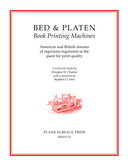
Charles. Bed & Platen. 2017
Charles, Douglas W. Foreword by Stephen O. Saxe. Bed & Platen Book Printing Machines: American and British streams of ingenious regression in the quest for print quality. Plane Surface Press, 2017.
This book is presented here with the kind permission of its author, Douglas W. Charles.
The icon at left links to a lower-resolution version of this book suitable for faster download and viewing on-screen (12 Megabytes). Here is a higher-resolution version suitable for printing (186 Megabytes): charles-bed-and-platen-print.pdf
There is a lot more difference in the basic kinematics of these various machines than one might at first think.
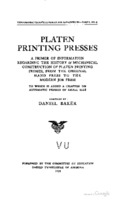
Platen Printing Presses
Baker, Daniel. Platen Printing Presses. (Chicago, IL: United Typothetae of America, 1918)
This is a local copy of the Google Books digitization of the University of Virginia copy.

Chandler & Price Gordon-Style Presses
These are the floor-standing platen printing presses made by the Chandler & Price firm. From 1884 to 1914, they produced a line of presses based on earlier work by George Phineas Gordon. Generally these are now called C&P "Old Series" presses because in 1911 C&P introduced a revised "New Series" version of this line. These continued in production until 1964 (according to the serial number lists, "Old Series" and New Series production overlapped). A much heavier "Craftsman" line was introduced in 1921 (also continuing in production until 1964). At some relatively late point a Model N was introduced.
See also the Notebooks on the Miller Platen Press Feeders (below), which were tightly integrated with C&P platen presses.
C&P also made a tabletop platen press, the Pilot. It is not covered here.
As background for understanding the C&P "Gordon" lines, it is useful to know something of the actual George P. Gordon presses (see below).
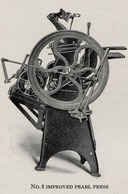
Golding
Golding & Co. made three primary lines of presses: the full-sized "Jobber," the smaller but capable "Pearl," and the tabletop "Official." So far, all I have is a bit on making roller trucks for the Pearl (Nos. 1 & 11).
See also the Stephen O. Saxe Archive of Amateur Press Catalogues for more Golding information.
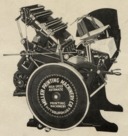
Miller Platen Printing Presses
The Miller "Master-Speed" (platen) press.

Miller Platen Press Feeders
These were tightly integrated into the Chandler & Price "New Series" and Craftsman Gordon-style presses.

Platen Press Press Accessories
[NOT DONE] Treadles, Motors, and Drive Pulleys. Brakes. Platen Guards. Ink Fountains and Vibrating Rollers. Flywheel Guards. Impression Counters [get Redington patent, 1908-10-13].
The Vandercook proof press (and knockoffs), now ubiquitous in letterpress printing studios, was never intended to be a production press. It was designed as a proof press to be used in conjunction with a higher-capacity production press.
Kyle Van Horn has created a lovely cut-and-fold paper Vandercook SP20: http://www.baltimoreprintstudios.com/2009/09/print-your-own-vandercook/ .
The definitive source for Vandercooks is Paul Moxon's Vandercook Proof Press Information Site. I believe he has a book out now, as well.
Distinction: In a cylinder press, the paper is wrapped around a cylinder and moves in relation to a flat bed which carries a (flat) form of type. A rotary press wraps both the paper and the type around cylinders. The wide adoption of the rotary press was enabled by the introduction of the stereotype plate, which could be cast in a cylindrical shape (although before that the Hoe firm did manufacture "revolving type" presses, the very concept of which is astonishing). The presses discussed in the present section are cylinder, not rotary, presses.

Cylinder Printing Machines (1918)
Baker, Herbert L. Cylinder Printing Machines. (Chicago, IL: United Typothetae of America, 1918)
This is a local copy of the Google Books digitization of the Harvard University copy.

Chandler & Price Cylinder
Instructions for the No. 2 Cylinder Press (including Specifications, with size and weight). Miscellaneous prints. One ad.

Miller Cylinder Printing Presses
The Miller "High-Speed" (cylinder) press.
The presses here are in fact relief printing machines not connected to telegraphs or computers, and thus legitimately printing presses. They are all, however, specialized in one way or another.

Davidson "Dual" Duplicators/Presses
Machines capable of both relief and lithographic printing. In relief printing mode they could be set up to use plates or equipped with a slotted "horizontal rail segment" to use Multigraph-compatible type and slugs. The question of whether they should be classified as "duplicators" (and thus office equipment) or a printing presses was at one time a matter of some controversy.

The Multigraph
[NOT DONE] This is a small hand-powered rotary press (yes, rotary rather than cylinder - the type rotates, not the paper). It is intended primarily to use hand-set type of a special form which slips into grooves around the periphery of a cylinder, but can also employ curved metal and rubber plates. [NOT DONE - REPRINT: everything Multigraph (non-Multilith) that I have.] [ATF Newsletter No. 23 - photo of a machine for rounding the surface of a German-made Multigraph-like printing machine.] [System: The Magazine of Business, 1903, 1907 Gammeter Multigraph]

The Addressograph
This is a link "up and over" (out of the "CircuitousRoot Typefoundry and Press" to the Circuitous Root Graphotype and Addressograph Notebooks). The Addressograph is in fact a relief printing press, but it is a rather specialized one intended primarily for printing from cold-metal type-plates formed by the Graphotype machine. I've got Addressograph models 30 (hand operated), 930 (power operated), and 970B (power operated and integrated with a desk).

The Monarch Junior
[NOT DONE] This is a special-purpose "printing press," of sorts: a mechanical tag or label maker which uses hand-set metal type.

Toy Printing Presses
[NOT DONE] [The Elm City toy printing kit.] [The Fulton No. 80.] [The Ideal "Big Press"] [Audrey Happy Meal Oil Truck.]

Proof Press and Brayer Combinations
[NOT DONE] A diverting historical dead end. [1887 Palmer and Rey specimen book, p. 302 djvu, "Proof Roller" - a brayer with side wheels to keep it galley-high.] [US patent 238,525. 1881-03-08 Wiliam Quail. Proof Press.]
Fashionable accessories for your little black press.

Inking
Rollers and Trucks; making Pearl trucks; Kelsey roller care instructions.
[NOT DONE] [Ink Fountains]

Feeding
[NOT DONE]
[Gauge Pins] [Grippers] [Automatic Feeders] [Impression Counters]
The 1909 Collier Stationery Company catalog from which the illustration of a letterpress comes is in the public domain. The extracts of it here remain in the public domain. Scanned by DMM from the original.
All portions of this document not noted otherwise are Copyright © 2008-2012 by David M. MacMillan and Rollande Krandall.
Circuitous Root is a Registered Trademark of David M. MacMillan.
This work is licensed under the Creative Commons "Attribution - ShareAlike" license, version 4.0 International. See http://creativecommons.org/licenses/by-sa/4.0/ for its terms.
Presented originally by Circuitous Root®